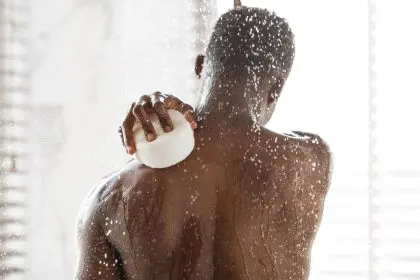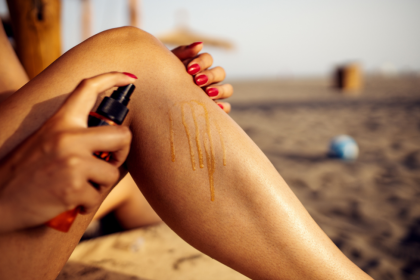When was the last time you let your skin truly breathe? Not just your face or hands, but the whole wonderland of your epidermis? If you’re struggling to remember, you’re not alone. Modern life keeps us wrapped up tight – in synthetic fabrics, under fluorescent lights, behind closed windows. But your body’s largest organ is quietly begging for some liberation.
Bare skin days – those glorious moments when you shed the unnecessary layers and let your skin connect directly with the world – aren’t just deliciously freeing. They’re actually essential for your physical and mental wellbeing in ways most of us never realized.
Let’s pull back the covers on why giving your skin some naked time might be the health revolution your body’s been waiting for.
Your skin is suffocating under all those layers
Your skin isn’t just a passive wrapper keeping your organs from falling out. It’s a dynamic, breathing entity that handles crucial biological processes – and it doesn’t function optimally when constantly covered.
Think about it: The average person wears clothes for 22+ hours a day. That’s like keeping your mouth covered with a mask almost constantly and wondering why your breathing feels restricted. Your skin needs to breathe, and not metaphorically.
Your skin actually performs a form of respiration, absorbing oxygen and releasing carbon dioxide directly through your pores. When continuously covered by synthetic fabrics especially, this exchange becomes compromised. The result? Your skin’s microbiome – that delicate ecosystem of beneficial bacteria living on your surface – gets thrown out of balance.
This matters because your skin microbiome doesn’t just prevent unwanted bacterial overgrowth – it communicates with your immune system, helps produce vital nutrients, and even affects your mood through the skin-brain axis.
The vitamin D connection nobody talks about
We’ve all heard about vitamin D and sunlight. But here’s what’s wild: the relationship between bare skin and this crucial vitamin is even more important than most doctors let on.
When UVB rays hit your bare skin, they trigger vitamin D synthesis that happens right in your skin cells. This process is dramatically more efficient than any supplement you could swallow. Just 10-30 minutes of midday sun exposure on bare skin can produce up to 10,000 IU of vitamin D – the equivalent of 100 standard vitamin D pills.
But here’s the kicker: clothing blocks this process almost entirely. Even lightweight fabrics can reduce vitamin D production by 95%. This means that even if you’re outdoors regularly, if you’re fully clothed, you’re likely still not getting adequate vitamin D.
And we’re not just talking about bone health here. Optimal vitamin D levels are linked to improved immune function, better mood, reduced inflammation, and even healthier weight maintenance. Some researchers now believe that the modern epidemic of vitamin D deficiency isn’t just about indoor living – it’s about our cultural aversion to letting our skin be naked.
Your temperature regulation has gone haywire
Ever notice how some people seem perfectly comfortable while you’re either sweating or freezing? Part of this might come down to how much bare skin time they get.
Your skin contains millions of thermoreceptors designed to sense environmental temperatures and help your body adapt accordingly. Regular exposure to varying temperatures through bare skin strengthens this system – a process scientists call “thermal adaptation.”
When you’re constantly clothed in climate-controlled environments, this sophisticated temperature regulation system weakens from lack of use. Much like a muscle atrophies without exercise, your body’s thermal adaptation becomes compromised.
People who regularly expose their skin to different temperatures – whether through bare skin time outdoors, contrast showers, or activities like skinny-dipping – report fewer issues with temperature sensitivity over time. Their bodies simply become more adept at handling temperature fluctuations without discomfort.
This thermal resilience doesn’t just make you more comfortable – it’s linked to better circulation, improved immune response, and even enhanced athletic performance. Your body responds to mild temperature challenges by becoming stronger, much like it responds to exercise by building muscle.
The sensory deprivation you never knew you had
Your skin contains around 5 million touch receptors, making it one of your richest sources of sensory information. These receptors aren’t just for detecting potential dangers – they play a crucial role in your nervous system development and ongoing mental health.
When your skin is constantly covered, you experience a form of sensory deprivation. The gentle stimulation of air currents, temperature variations, and natural textures gets filtered out by clothing. Over time, this subtle but chronic sensory deprivation can contribute to feelings of disconnection, anxiety, and even depression.
Research on “sensory processing” shows that regular, varied touch experiences help regulate your nervous system. The direct sensory input of air, sun, water or natural surfaces on bare skin activates parasympathetic responses – your body’s “rest and digest” mode – counteracting the chronic stress most of us experience.
This explains why activities involving skin exposure – swimming in natural water, sunbathing, or even just sleeping naked – often feel deeply restorative beyond what you’d expect from the activity itself. You’re not just relaxing – you’re giving your nervous system the sensory nourishment it evolved to expect.
Your sleep quality tanks when your skin can’t breathe
The connection between bare skin and sleep quality is one of those obvious-once-you-hear-it revelations. Your body temperature needs to drop by about 1-2 degrees to initiate and maintain quality sleep. This cooling process happens primarily through your skin.
When you sleep fully clothed or under synthetic, non-breathable bedding, your body struggles to regulate its temperature. Studies using thermal imaging have shown that people sleeping naked or in minimal, natural fiber clothing maintain more optimal sleep temperatures throughout the night.
Beyond temperature regulation, there’s another fascinating reason bare skin improves sleep: melatonin production. Your pineal gland produces this sleep-inducing hormone in response to darkness, but it also responds to skin exposure. Research suggests that skin actually contains melatonin receptors, and sleep with more skin exposure improves melatonin’s effectiveness.
The evidence speaks for itself – people who sleep with more skin exposed report falling asleep faster, experiencing fewer nighttime awakenings, and feeling more rested in the morning. All from simply letting their skin breathe during the third of their life spent sleeping.
Your skin-brain connection needs direct input
One of the most surprising discoveries in recent neurological research is just how much your skin communicates directly with your brain. This “skin-brain axis” operates through multiple pathways, including sensory neurons, immune signaling, and hormone production.
When your skin receives diverse natural stimuli – the warmth of sunshine, the cool kiss of a breeze, the varied texture of grass or sand – it transmits this rich sensory information to your brain. This input triggers the release of mood-enhancing neurotransmitters like serotonin and dopamine while reducing stress hormones like cortisol.
In contrast, when your skin is constantly covered, especially by synthetic fabrics, it receives a monotonous sensory input that creates a form of neurological boredom. Your brain evolved expecting varied sensory messages from your skin – the deprivation of these signals may contribute to the epidemic of anxiety and mood disorders in modern societies.
This skin-brain connection explains why activities like “grounding” or “earthing” – directly connecting bare skin with natural surfaces like soil, grass or water – show measurable improvements in stress hormone levels, inflammation markers, and even brain wave patterns in research studies.
The forgotten social dimension of skin exposure
Humans are the only mammals that permanently cover their skin. While cultural modesty certainly has its place, our extreme aversion to communal skin exposure represents a dramatic departure from most of human history.
Until very recently, humans around the world regularly engaged in communal bathing, swimming, and other activities that normalized non-sexual skin exposure. These practices weren’t just about hygiene – they provided important social bonding while normalizing realistic body expectations.
The sharp decline in these experiences correlates with rising body image issues and skin-related anxieties. When we only see idealized bodies in media and rarely experience the natural diversity of human forms, our relationship with our own skin often suffers.
Communities that maintain healthy traditions of non-sexual communal skin exposure – whether through bathhouse cultures, nude beaches, or outdoor swimming traditions – report better body image satisfaction and lower rates of appearance-related anxiety. The simple act of seeing normal, diverse bodies helps counteract the distorted expectations created by constant clothing and media imagery.
Starting small with strategic skin freedom
You don’t need to become a full-time nudist to reap the benefits of bare skin time. Even small, strategic moments of skin freedom can make a meaningful difference to your health.
Start with sleep. Simply switching to sleeping in less clothing, or none at all, gives your skin 6-8 hours of breathing time every 24 hours. Natural fiber sheets like cotton or linen maximize this benefit by allowing better airflow around your skin.
Morning routines offer another opportunity. Consider delaying getting dressed for 15-30 minutes after your shower. Let your skin fully dry naturally while you have breakfast or prepare for the day. This brief daily ritual provides valuable skin-air contact time.
For vitamin D benefits, even brief midday sun exposure helps. Just 10-15 minutes with arms, legs, or torso exposed a few times weekly significantly boosts your natural vitamin D production. Always be mindful of sunburn risk, but remember that sensible sun exposure is very different from sunbathing for hours.
Home-based activities like yoga, stretching, or meditation can be enhanced by doing them with more skin exposed. Not only does this improve the physical benefits through better temperature regulation, but it also amplifies the mind-body connection that these practices develop.
The benefits of reconnecting your skin with the natural world aren’t just some woo-woo wellness trend. They’re backed by emerging research in chronobiology, immunology, and neuroscience. Your skin evolved for direct interaction with the environment – and giving it regular opportunities to fulfill this biological expectation might be one of the simplest yet most profound health adjustments you can make.
Your bare skin isn’t something to hide or be ashamed of. It’s a magnificent organ waiting to help you feel more alive, more connected, and genuinely healthier. Maybe it’s time to let it breathe.

















